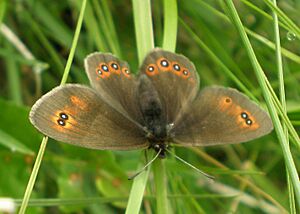Bright eyed ringlet facts for kids
Quick facts for kids Bright eyed ringlet |
|
|---|---|
 |
|
| Scientific classification | |
| Genus: |
Erebia
|
| Species: |
oeme
|
The bright eyed ringlet (Erebia oeme) is a lovely butterfly. It is part of the Nymphalidae family, which includes many well-known butterflies. This special butterfly lives high up in the mountains. You can find it in places like the Pyrenees, Massif Central, Alps, and Balkan mountains. Recently, it was also found in the southern Carpathians.
Contents
About the Bright Eyed Ringlet
The bright eyed ringlet butterfly is known for its unique look. Its forewings, which are the front wings, usually measure between 28 and 36 millimeters long. This makes it a medium-sized butterfly.
What It Looks Like
This butterfly has a generally dark brown color. On its forewings, near the top, you can often see a reddish-yellow spot. This spot usually has two black "eyespots" with white centers. These are called ocelli. On its hindwings, which are the back wings, it has two to four more of these white-centered eyespots. These are also surrounded by reddish-yellow.
When you look at the underside of its wings, they are grey-brown. The eyespots look similar to those on the top side. Female bright eyed ringlets are often a bit larger than males. Their colors are usually lighter, and their eyespots are bigger and stand out more. The underside of their hindwings can be yellowish-grey.
Different Forms of the Butterfly
Sometimes, you might see slightly different versions of the bright eyed ringlet. For example, there's a form called lugens. These butterflies are smaller and have forewings that are a solid black-brown color on top. Another form, spodia, is usually a bit larger. It has a full band of color on both its front and back wings. Its eyespots are also larger and have very clear white centers. These different forms show how varied butterflies can be!
Life Cycle of the Butterfly
Like all butterflies, the bright eyed ringlet goes through several stages.
Eggs and Larvae
The eggs of the bright eyed ringlet are round and shiny white. Once the eggs hatch, a larva, or caterpillar, emerges. These caterpillars are similar in shape to other butterfly caterpillars. However, they are not green. Instead, they are a pale, clay-like color with brownish lines running along their bodies. Each body segment has a dark line made of four connected black spots. They also have a chocolate-brown stripe along their sides, just above their legs.
What Caterpillars Eat
These caterpillars enjoy eating various types of grasses. Some of their favorite foods include Poa alpina, Poa pratensis, Poa nemoralis, and Festuca rubra. They also feed on sedges like Carex flacca and Carex sempervirens, and other grasses such as Briza media and Molinia caerulea.
Pupae and Adults
After growing enough, the caterpillar turns into a pupa. The pupa is a pale yellow color. The parts that will become the eyes, tongue, and wings of the adult butterfly are outlined in brown. The adult bright eyed ringlet butterfly usually flies from June to August. They have one generation each year, meaning they complete their full life cycle once in that period.
Images for kids


